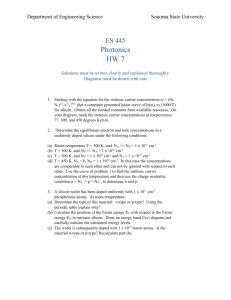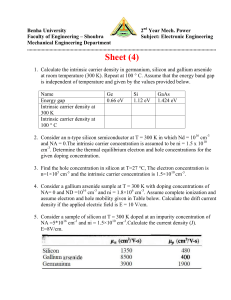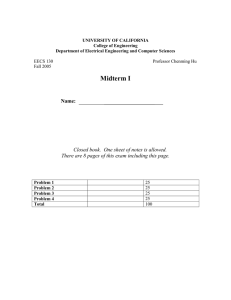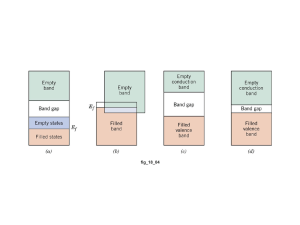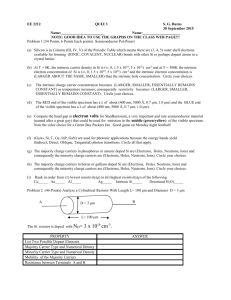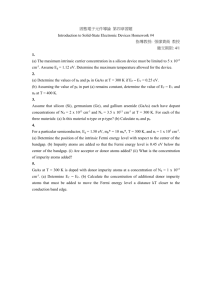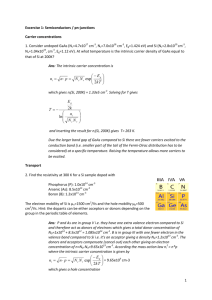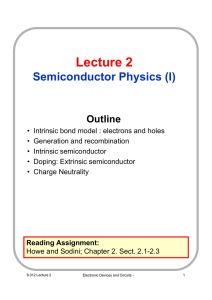Semiconductor Physics Homework Solutions: Doping & Conductivity
advertisement
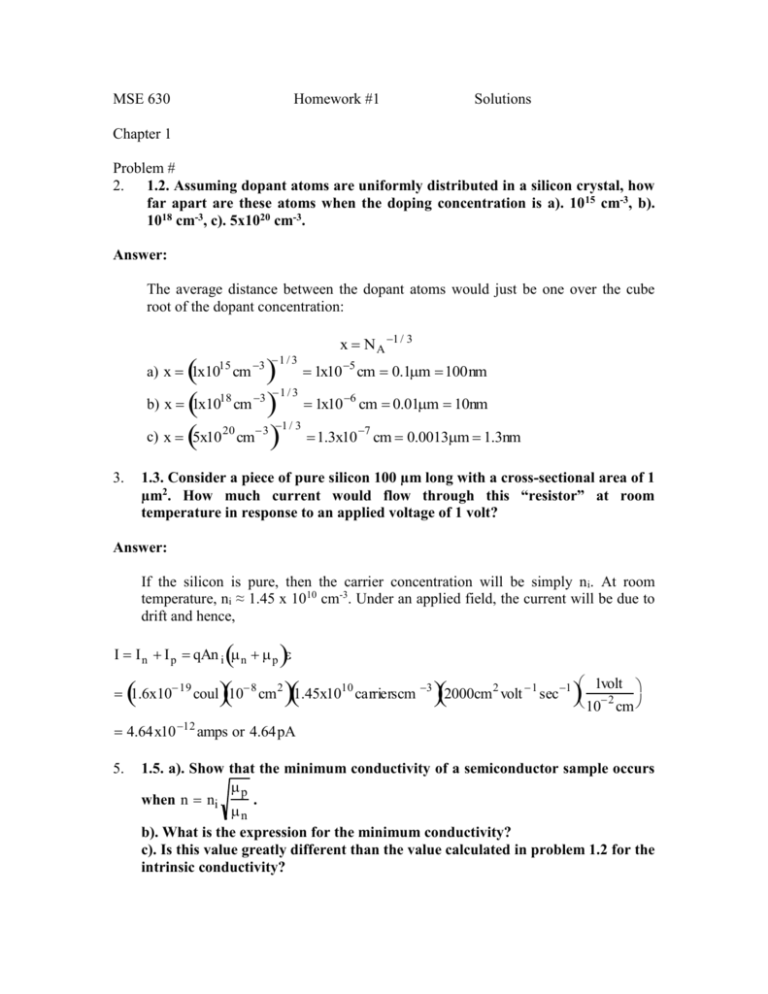
MSE 630 Homework #1 Solutions Chapter 1 Problem # 2. 1.2. Assuming dopant atoms are uniformly distributed in a silicon crystal, how far apart are these atoms when the doping concentration is a). 10 15 cm-3, b). 1018 cm-3, c). 5x1020 cm-3. Answer: The average distance between the dopant atoms would just be one over the cube root of the dopant concentration: b) x 1x10 c) x 5x10 a) x 1x1015 cm 3 18 3. cm 3 20 cm3 x N A 1 / 3 1 / 3 1x10 5 cm 0.1m 100nm 1 / 3 1x10 6 cm 0.01m 10nm 1 / 3 1.3x10 7 cm 0.0013m 1.3nm 1.3. Consider a piece of pure silicon 100 µm long with a cross-sectional area of 1 µm2. How much current would flow through this “resistor” at room temperature in response to an applied voltage of 1 volt? Answer: If the silicon is pure, then the carrier concentration will be simply ni. At room temperature, ni ≈ 1.45 x 1010 cm-3. Under an applied field, the current will be due to drift and hence, I I n I p qAn i n p 1.6x10 19 coul 10 8 cm 2 1.45x1010 carrierscm 3 2000cm 2 volt 1 sec 1 101voltcm 2 4.64x10 12 amps or 4.64pA 5. 1.5. a). Show that the minimum conductivity of a semiconductor sample occurs p when n ni . n b). What is the expression for the minimum conductivity? c). Is this value greatly different than the value calculated in problem 1.2 for the intrinsic conductivity? Answer: a). 1 q n n p p To find the minimum we set the derivative equal to zero. 2 2 n q n n p nni q n p nn i2 0 q nn pp n n p n 2 n 2i n p or n ni n b). Using the value for n derived above, we have: p n2i min q n n i p p n ni n c). p n q n n 2qn i n p n i p i n p The intrinsic conductivity is given by i qni n p Taking values of ni = 1.45 x 1010 cm-3, µn = 1500 cm2 volt-1 sec-1 and , µp = 500 cm2 volt-1 sec-1, we have: i 4.64x10 6 cm and min 4.02x10 6 cm Thus there are not large differences between the two. 1.6. When a Au atom sits on a lattice site in a silicon crystal, it can act as either a donor or an acceptor. ED and EA levels both exist for the Au and both are close to the middle of the silicon bandgap. If a small concentration of Au is placed in an N type silicon crystal, will the Au behave as a donor or an acceptor? Explain. Answer: In N type material, the Fermi level will be in the upper half of the bandgap as shown in the band diagram below. Allowed energy levels below EF will in general be occupied by electrons. Thus the ED and EA levels will have electrons filling them. This means the donor level will not have donated its electron whereas the acceptor level will have accepted an electron. Thus the Au atoms will act as acceptors in N type material. 1.8. Construct a diagram similar to Figure 1-27b for P-type material. Explain physically, using this diagram, why the capture of the minority carrier electrons in P-type material is the rate limiting step in recombination. Answer: In P type material (on the right), there are many more holes than electrons. Thus the probability of capturing a hole by the trap is high compared to electrons. So the normal state of occupancy of the trap level will be with a hole present. The recombination rate will then be limited by the capture of the "scarce" species which is the minority carrier or electron in this case. Stated another way, since EF is below the trap level in P type material, ET will normally not be occupied by an electron. Thus the limiting process is the electron capture. 1.9. A silicon diode has doping concentrations on the N and P sides of N D = 1 x 1019 cm-3 and of NA = 1 x 1015 cm-3. Calculate the process temperature at which the two sides of the diode become intrinsic. (Intrinsic is defined as ni = ND or NA.) Answer: Each side of the diode will become intrinsic at the temperature at which n I = ND or NA. We can estimate these temperatures by looking at the graph in Fig. 1-16. From the graph, the N side of the diode will become intrinsic around 1400K or 1100˚C. The P side will become intrinsic at a lower temperature since NA is smaller than ND. From the figure, the P side becomes intrinsic at about 500K or 200˚C. More accurately, we solve Eqn. 1.4 to find the exact temperature. Thus 0.603eV n i 3.1x1016 T3 / 2 exp kT Setting nI = 1019 cm-3 and 1015 cm-3 respectively, we and solving by iteration, we find that the N side becomes intrinsic at about 1380K or about 1110˚C and the P side becomes intrinsic at about 545K or about 270˚C.

